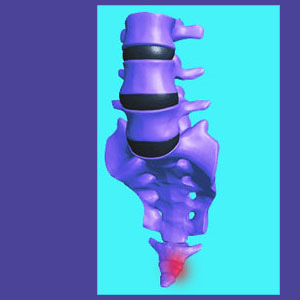
Coccyx injury is a common cause of tailbone pain and a leading justification for coccyx surgery, as well. Since the coccyx structure is fragile and in a bad location, it is susceptible to trauma from falls and other possible accidents.
The coccyx has shown itself to be a very problematic structure in humans, since it has no purpose and is often blamed for causing pain. Injury to the tailbone can result in bruising, fracture, bone displacement and neurological damage in very rare instances.
This post examines the causes, symptoms and consequences of coccyx trauma. If you have injured your tailbone and need help, then this is the right research material for you.
Coccyx Injury Causes
The coccyx does not feature any protective mechanism, with the possible exception of lots of buttocks padding in obese people. Furthermore, some people have a prominent coccyx that is particularly susceptible to trauma. Here are some of the major sources of trauma to the tailbone:
The most common sources of coccyx trauma are falls. Falling on the buttocks can result in the coccyx taking a direct hit from a hard surface. This can occur on slippery surfaces, like in the shower or bathtub, or when participating in various activities, like sports.
The coccyx region can suffer soft tissue trauma in people who must lie on it nonstop (bedridden people confined to their back) or people who must sit (like in a wheelchair) for most of their time. This is especially common in thin people with little natural tissue padding surrounding the tailbone.
The coccyx region can suffer ligamentous injury due to many possible circumstances, including losing one’s balance, lifting weight and any strenuous circumstance.
Coccyx Symptoms
Following injury (or perceived injury), there are many possible expressions that might make life miserable for any affected patient:
Coccyx pain might be present all the time, but is usually reserved for times when pressure is applied to the tailbone (sitting, lying on one’s back) and when performing strenuous labor involving the region, such as lifting.
The patient may express neurological symptoms like tingling, numbness or regional weakness in addition to pain, or even in place of pain.
Rare cases might involve damage to the coccygeal nerve which can cause objective sensory deficits regionally.
Treatment for Coccyx Injury
Most instances of trauma to the tailbone are not serious, although they may be painful for a long time. Deep bruising can really hurt and may endure for weeks or even a few months. This describes the most common instances of coccyx trauma. Generally, care is conservative, with ice, pharmaceutical therapy, activity avoidance and rest being the most commonly prescribed interventions.
The coccyx is not a single piece of bone. It consists of several fused sections of bone and tends to fracture along these lines of demarcation. Fracture sounds bad, but in most cases, very little treatment is needed. In most cases, fractures that are not displaced will be monitored and left alone. For displaced fractures, closed or open (surgical) reduction of the break may be needed.
Coccyx surgery is used in cases of severe trauma or in many patients with chronic pain that defies conservative care. Surgery can seek to rectify trauma, like fractures, but is often used to completely remove the coccyx, since this is easy to do and comes with no real downside. Coccyx removal is relatively effectual at reducing pain once healing has taken place. However, in many chronic idiopathic coccyx pain profiles, surgery does nothing to relieve pain, even after the tailbone has been removed. In these cases, it is obvious that the condition was misdiagnosed all along and is most likely created by a mindbody syndrome. Treatment with knowledge therapy has proven itself to be exponentially more effective than coccyx surgery in these patients.





